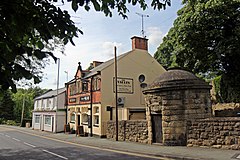Ruabon brick
Ruabon
|
|
|---|---|
 The Vaults public house and the roundhouse, Ruabon |
|
| Ruabon shown within Wrexham | |
| Population | 4,274 (2011 Census) |
| OS grid reference | SJ303438 |
| Community |
|
| Principal area | |
| Ceremonial county | |
| Country | Wales |
| Sovereign state | United Kingdom |
| Post town | WREXHAM |
| Postcode district | LL14 |
| Dialling code | 01978 |
| Police | North Wales |
| Fire | North Wales |
| Ambulance | Welsh |
| EU Parliament | Wales |
| UK Parliament | |
| Welsh Assembly | |
Ruabon (Welsh: Rhiwabon pronounced [r̥ɪʊˈɑːbɔn]) is a village and community in the county borough of Wrexham in Wales. The name "Rhiwabon" comes from "Rhiw Fabon", "Rhiw" being the Welsh word for "hill" and "Fabon" being a mutation from St Mabon, the original church name, of earlier, Celtic origin (see Mabon)." An older English spelling, Rhuabon, can sometimes be seen.
In 2001, more than 80% of the population of 2,400 were born in Wales with 13.6% having some ability in Welsh.
There is evidence that a settlement existed in Ruabon in the Bronze Age. In 1898, building works in the centre of Ruabon exposed a cist or stone urn containing cremated human remains dating from 2000 years BC. In 1917, the remains of a Bronze Age round barrow were discovered on the playing fields of Ruabon Grammar School; they contained human remains, a flint arrowhead and a bronze axe.
Overlooking Ruabon, the Gardden (Welsh: Caer Ddin), an ancient hillfort surrounded by circular ditches, dating back to the Iron Age.
The ancient parish of Ruabon was made up of the townships of: Ruabon (which also included the hamlets of Belan, Bodylltyn, Hafod and Rhuddallt); Cristionydd Cynrig (also known as Y Dref Fawr or Cristionydd Kenrick in English); Coed Cristionydd; Cristionydd Fechan (also known as Y Dref Fechan or Dynhinlle Uchaf); Dinhinlle Isaf; Morton Anglicorum (the “English Morton” or Morton Below the Dyke); and Morton Wallichorum (the “Welsh Morton” or Morton Above the Dyke).
...
Wikipedia

